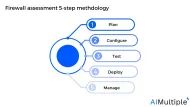Encryption Key Management: Benefits, Tools & Best Practices in 2024
In 2022, the average cost of a data breach in the U.S. was estimated to be 9 million U.S. dollars.1 With the growing cost of data breaches over the years and the use of digital communication and storage, ensuring the confidentiality, integrity, and authenticity of sensitive information has become crucial.2
Encryption is a widely used method for achieving these goals; however, managing the encryption keys to secure the data is challenging.3
This article aims to provide:
- Benefits of encryption key management
- Techniques of encryption key management
- Protocols used to secure encryption keys
- The best practices for encryption key management
What is encryption key management?
Encryption key management refers to the administration and protection of the keys used to encrypt and decrypt data. This includes
- Generation
- Storage
- Distribution
- Replacement
of encryption keys, as well as the procedures for using them.
The goal of encryption key management is to ensure the encrypted data’s
- Confidentiality
- Integrity
- Authenticity
Thus, it can minimize the risks associated with key loss, theft, or misuse. This requires careful planning, secure systems, and well-defined policies and procedures, as the security of the encrypted data is directly dependent on the safety of the encryption keys.
What is the encryption key management lifecycle?
The encryption key management lifecycle is the process of securely creating, storing, distributing, using, replacing, backing up, monitoring, and destroying cryptographic keys. (See Figure 1) It includes the following stages:
- Key Generation: Creating new encryption keys using secure methods, such as random number generators.
- Key Storage: Securely storing encryption keys, typically using encrypted repositories such as hardware security modules (HSMs) or encrypted databases.
- Key Distribution: Securely distributing encryption keys to authorized individuals or systems.
- Key Use: The process of using encryption keys to encrypt and decrypt data and to sign and verify digital signatures securely.
- Key Replacement: Regularly replacing encryption keys to reduce the risk of exposure.
- Key Backup: The process of regularly backing up encryption keys to ensure that they can be recovered in case of loss or damage.
- Key Monitoring: The process of monitoring the use of encryption keys to detect and respond to potential security incidents.
- Key Destruction: Securely destroying encryption keys when no longer needed to reduce the risk of exposure.
Source: Omdia4
Figure 1. Encryption key management lifecycle
Each of these stages is critical to the effective and secure management of cryptographic keys and must be carefully planned and executed to ensure the security of the encrypted data. The encryption key management lifecycle provides a structured approach to managing cryptographic keys and helps organizations ensure the protection and confidentiality of their sensitive data.
Top 5 benefits of encryption key management
Encryption key management is an essential component of modern information security and is critical for ensuring the confidentiality, integrity, and availability of sensitive information.
1- Ensuring confidentiality
Encryption key management ensures that only authorized individuals can access the encryption keys needed to decrypt sensitive information.
2- Ensuring integrity
Encryption key management helps ensure encrypted data’s integrity by preventing unauthorized changes or tampering.
3- Ensuring availability
Encryption key management helps ensure encrypted data availability by providing methods for key recovery in case of loss or damage.
4- Complying with industry standards
Encryption key management is often required by regulations and industry standards, such as the Payment Card Industry Data Security Standard (PCI DSS) and the Health Insurance Portability and Accountability Act (HIPAA).
5- Maintaining security
Effective encryption key management helps to reduce the risk of security incidents, such as data breaches, by making it harder for attackers to access or misuse encryption keys.
What are the encryption key management software solutions?
Several encryption key management software solutions are available on the market, including
- Microsoft Azure Key Vault: Microsoft Azure Key Vault is a cloud-based service provided by Microsoft that allows you to securely store and manage sensitive information, such as keys, passwords, certificates, and other critical information. You can integrate with other Azure services and tools, such as Azure Active Directory, to provide a streamlined and secure experience.
- AWS Key Management Service: Amazon Web Services (AWS) Key Management Service (KMS) is a key management service provided by Amazon. You can create and manage encryption keys that are used to encrypt your data stored in AWS services such as S3, EBS, and RDS.
- Google Cloud Key Management Service: With GCP, you can create and manage encryption keys that are used to encrypt your data stored in GCP services such as Google Cloud Storage, Google Compute Engine, and Google Bigtable.
- IBM Cloud Key Protect: With IBM Cloud Key Protect, you can use other IBM Cloud services and tools, such as IBM Cloud Identity and Access Management, to provide a streamlined and secure experience while protecting your keys in a secure environment.
Each software solution provides different features and benefits and can be tailored to meet the specific needs of various organizations.
The best encryption key management software for a particular organization will depend on factors such as
- Size and complexity of the organization’s encryption environment,
- Types of data being protected
- Regulatory and compliance requirements must be met.
10 encryption key management best practices
Encryption key management best practices are guidelines and recommendations for securely managing encryption keys throughout their lifecycle. The following are some essential practices for encryption key management.
1- Ensure centralized management
Establish a centralized repository for storing and managing encryption keys and implement appropriate security controls to protect the repository and its keys.
2- Secure key generation
Secure key generation is the process of creating cryptographic keys used for encryption and decryption. A secure key generation algorithm should generate keys that are random, unique, and unpredictable to ensure the security of encrypted communications.
3- Assure key storage
Store encryption keys securely using encrypted repositories such as hardware security modules (HSMs) or encrypted databases. Implement appropriate access controls to limit who can access the keys.
4- Secure key distribution
Secure key distribution refers to the secure transfer of cryptographic keys from one party to another. This is an essential step in establishing secure communication between two parties.It helps prevent eavesdropping and tampering of messages, thereby ensuring the security of the communication.
5- Allow regular key replacement
Regular key replacement refers to regularly replacing or updating cryptographic keys in a secure system. This is an essential aspect of key management and helps maintain the security of encrypted communications.
6- Secure key backup
Regularly backup encryption keys and store the backups in a secure location to ensure that they can be recovered in case of loss or damage.
7- Enable key monitoring
Monitor the use of encryption keys and alert administrators to potential security incidents, such as unauthorized access or attempts to use the keys.
8- Secure key destruction
Securely destroy encryption keys when they are no longer needed, using methods such as overwriting or physically destroying them to reduce the risk of exposure.
9- Achieve compliance
Ensure encryption key management practices comply with relevant regulations and standards, such as PCI DSS, HIPAA, and others.
10- Facilitate regular review
Regularly review and update encryption key management processes and procedures to ensure that they continue to meet the evolving security needs of the organization.
Implementing these best practices can help organizations ensure the security and confidentiality of their sensitive data and can help reduce the risk of data breaches and other security incidents.
If you have further questions about cybersecurity, don’t hesitate to reach us:
External Links
- 1. “Average cost of a data breach in the United States from 2006 to 2022” Statista, July 2022
- 2. “Average cost of a data breach in the United States from 2006 to 2022” Statista, July 2022
- 3. “Use of enterprise encryption technologies worldwide in 2021, by business area” Statista, May 2022
- 4. “Fundamentals of Encryption Key Management (EKM)” Omdia, 24 Aug 2021



Comments
Your email address will not be published. All fields are required.